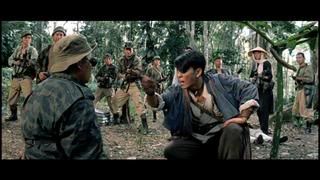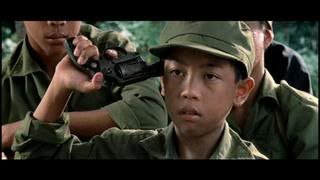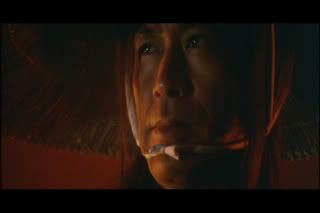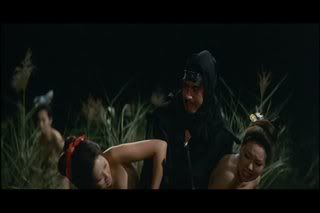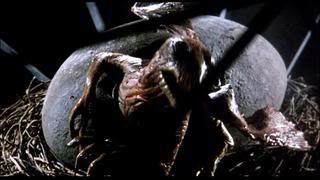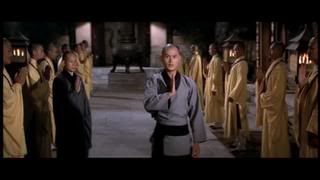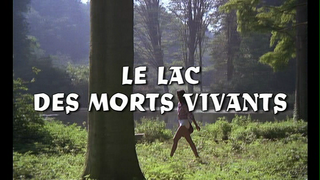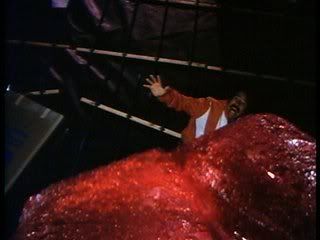
The first time I saw John Carpenter's The Thing I would have been around 13 or 14 years old and staying overnight at my cousin's house. We rented a bunch of horror movies and decided to stay up all night watching them, and things were going well up until three in the morning or so. That's when we popped in this horror classic. We were repulsed by the gory effects and tense atmosphere of the first half, but then comes the blood test scene.
Hoo boy. The blood test scene.
I'm not going to give too much away, but the film features an alien creature that can copy the appearance of any living thing it encounters, and at one point in the film the main character discovers that each cell of the creature works as a living organism (horrifically demonstrated in a scene where the head of the creature pulls away from the body of a person it is copying, sprouts spider legs and attempts to walk away).. He postulates that if this is the case then the blood of someone who is "infected" would move away from a hot needle.
Tying the paranoid crew to chairs, the character tests them one at a time. A hot wire being laid into a petri dish of each character's blood. After several tests revealing nothing (and exonerating characters that the audience may have suspected) there comes the single biggest fright i've ever gotten from a horror film. I already knew at this point that the film was something special, but this moment pushed it over the line as one of my very favorite films.

When released in 1982, The Thing was a very modest financial success, and got only mixed critical reviews. It came out the same summer as Steven Spielberg's E.T., and it's theorized in the special features that audiences were not prepared to watch such a nihilistic science fiction film after seeing Spielberg's cutesy classic. The years since have found an increasing number of people discovering the greatness of the film, with it joining a number of John Carpenter's films that took some time to find an audience (such as They Live, Big Trouble In Little China and even In The Mouth Of Madness).
The film centers on a group of scientists in a remote base in Antarctica. One day they are startled to see a helicopter circling their base, apparently attempting to attack a dog that is racing through the snow towards them. After landing, one of the helicopter's inhabitants chase the dog towards the men, firing blindly in an attempt to kill it. After accidentally blowing up the helicopter, the inhabitant shouts Norwegian before wounding one of the scientists in the leg, and is subsequently shot and killed. Startled and confused, the men take the dog into the base before helicopter pilot R.J. MacReady decides to head to the Norwegian camp to see what caused all of this. On arrival they find the base demolished, and the grisly remains of something that appears half human. An autopsy reveals that the remains are at least partly human, and it is soon discovered that the parts are actually pieces of the title creature, who can copy organisms exactly if given a short amount of time. Soon, the men are in a fight for their lives as the paranoia of who has and hasn't been taken over starts to breed mistrust. The film comes to an explosive conclusion as the remaining men desperately try to stop the creature from escaping and eventually reaching populated civilization.

Setting a horror film in the barren arctic is something that strongly appeals to me. The starkness and remoteness of the situation, along with the extreme conditions that push people close together, seems to be a wonderful recipe for tension. While recent films like 30 Days Of Night have had a difficult time building appropriate fear, Carpenter was already well seasoned in terror by the time he made this film, already having made Halloween (1978) and The Fog (1980).
Aside from the setting, however, the reason the film works relies on the efforts of the entire cast and crew. The score by the amazing Ennio Morricone (which sounds strangely like one of Carpenter's own scores) builds dread effectively, and the Cinematography by Dean Cundey squeezes the tension out of every corner. But the real MVP of the film (aside from the cast, and Carpenter himself) are the horrific creations of Rob Bottin (The Howling, Robocop). Bringing the twisted nightmare of a creature that can copy other creatures to life, Bottin's work remains unparalleled in terms of special make-up effects, and may be the peak of pre-computer age make-up in horror films. Each horrific set-piece is like a demented work of art, and it's not difficult to see why he was hospitalized for exhaustion from the amount he put into the film.
The film wouldn't exist without Carpenter's vision to guide it, and he was at the height of his powers here. Working with an all male ensemble, he squeezes his grip around the audience's neck slowly, bringing things to a fever pitch several times before giving a few moments of relief. Carpenter seems to enjoy visions of apocalypse, and explored this theme again in Prince Of Darkness and In The Mouth Of Madness, but the hopelessness of the situation presented (as well as the parallels to blood diseases like AIDS) rises The Thing above much of his other work. Personally, I think this is the best work he's ever done. In both the included documentary, as well as the commentary, much mention is made of the difficulty of shooting dialogue scenes of a small room filled with actors. Onlookers seem amazed at the way that Carpenter deftly approaches such moments, and it takes a close look to appreciate the skill that Carpenter brings to a production.

The acting is spot on, with Russell being the stand out as the reluctantly heroic Macready. With a full beard hiding his movie star appearance Russell is totally believable as a desperate man trying to retain trust while the situation around him slowly begins to collapse. The rest of the cast acquit themselves very well, with Wilfred Brimley as Dr. Blair (who is the first to discover the danger they have found themselves in) showing impressive manic energy as he attempts to prevent the creature from reaching humanity.
This is not a pleasant movie. It's gory to the point of disgust in certain scenes (particularly when the men dissect the burned corpses), and while the ending is appropriate to the film, it doesn't provide anything close to happy conclusion. But this is a thinking mans horror film. An amazing piece of entertainment that survives because of the questions it raises. Created as a tribute to the original The Thing From Another World, as well as a more accurate adaptation of the source story Who Goes There by Joseph Campbell, the film betters on the original materials in almost every way.

The DVD of The Thing I own is the 1998 Collectors Edition, which was later released with a different cover in 2004. The major difference between the two is that the newer version's print has been enhanced for 16x9 televisions. The film is presented in its original 2.35:1 aspect ratio, and Carpenter once again proves himself a master of getting as much possible out of the frame. This film is sometimes shown in a heavily edited form on television, but I strongly suggest only ever seeing the film in its original presentation. The image quality is sharp, and the scenes of the icy glacier on which they filmed are impressive.
The DVD comes packed with special features, the most impressive being the documentary Terror Takes Shape, documenting the making, and release, of the film. Running 84 minutes, the documentary provides a candid, fascinating look at the difficulties of shooting the film. Including almost all of the major players involved with its creation, it's highly recommended to fans of the film or fans of film documentaries.
We're also treated to a feature length commentary from Carpenter and Kurt Russell. The men obviously have a lot of fondness for the film, and a close friendship, and their memories are both genial and often hilarious. I've heard a number of commentaries from the two at this point, and they never disappoint. Also included are a production background archive, cast production photographs, production art/storyboards, location design, production archives, small sections on the designing of the alien's flying saucer, the design of the Blair monster, several outtakes, production notes, and the original trailer for the film (which I quite like). All together a wonderful package that treats the film with deserved respect.
A horror classic that has amassed a cult audience in the decades since its release, The Thing remains a high point of 80s horror.
Hoo boy. The blood test scene.
I'm not going to give too much away, but the film features an alien creature that can copy the appearance of any living thing it encounters, and at one point in the film the main character discovers that each cell of the creature works as a living organism (horrifically demonstrated in a scene where the head of the creature pulls away from the body of a person it is copying, sprouts spider legs and attempts to walk away).. He postulates that if this is the case then the blood of someone who is "infected" would move away from a hot needle.
Tying the paranoid crew to chairs, the character tests them one at a time. A hot wire being laid into a petri dish of each character's blood. After several tests revealing nothing (and exonerating characters that the audience may have suspected) there comes the single biggest fright i've ever gotten from a horror film. I already knew at this point that the film was something special, but this moment pushed it over the line as one of my very favorite films.

When released in 1982, The Thing was a very modest financial success, and got only mixed critical reviews. It came out the same summer as Steven Spielberg's E.T., and it's theorized in the special features that audiences were not prepared to watch such a nihilistic science fiction film after seeing Spielberg's cutesy classic. The years since have found an increasing number of people discovering the greatness of the film, with it joining a number of John Carpenter's films that took some time to find an audience (such as They Live, Big Trouble In Little China and even In The Mouth Of Madness).
The film centers on a group of scientists in a remote base in Antarctica. One day they are startled to see a helicopter circling their base, apparently attempting to attack a dog that is racing through the snow towards them. After landing, one of the helicopter's inhabitants chase the dog towards the men, firing blindly in an attempt to kill it. After accidentally blowing up the helicopter, the inhabitant shouts Norwegian before wounding one of the scientists in the leg, and is subsequently shot and killed. Startled and confused, the men take the dog into the base before helicopter pilot R.J. MacReady decides to head to the Norwegian camp to see what caused all of this. On arrival they find the base demolished, and the grisly remains of something that appears half human. An autopsy reveals that the remains are at least partly human, and it is soon discovered that the parts are actually pieces of the title creature, who can copy organisms exactly if given a short amount of time. Soon, the men are in a fight for their lives as the paranoia of who has and hasn't been taken over starts to breed mistrust. The film comes to an explosive conclusion as the remaining men desperately try to stop the creature from escaping and eventually reaching populated civilization.

Setting a horror film in the barren arctic is something that strongly appeals to me. The starkness and remoteness of the situation, along with the extreme conditions that push people close together, seems to be a wonderful recipe for tension. While recent films like 30 Days Of Night have had a difficult time building appropriate fear, Carpenter was already well seasoned in terror by the time he made this film, already having made Halloween (1978) and The Fog (1980).
Aside from the setting, however, the reason the film works relies on the efforts of the entire cast and crew. The score by the amazing Ennio Morricone (which sounds strangely like one of Carpenter's own scores) builds dread effectively, and the Cinematography by Dean Cundey squeezes the tension out of every corner. But the real MVP of the film (aside from the cast, and Carpenter himself) are the horrific creations of Rob Bottin (The Howling, Robocop). Bringing the twisted nightmare of a creature that can copy other creatures to life, Bottin's work remains unparalleled in terms of special make-up effects, and may be the peak of pre-computer age make-up in horror films. Each horrific set-piece is like a demented work of art, and it's not difficult to see why he was hospitalized for exhaustion from the amount he put into the film.
The film wouldn't exist without Carpenter's vision to guide it, and he was at the height of his powers here. Working with an all male ensemble, he squeezes his grip around the audience's neck slowly, bringing things to a fever pitch several times before giving a few moments of relief. Carpenter seems to enjoy visions of apocalypse, and explored this theme again in Prince Of Darkness and In The Mouth Of Madness, but the hopelessness of the situation presented (as well as the parallels to blood diseases like AIDS) rises The Thing above much of his other work. Personally, I think this is the best work he's ever done. In both the included documentary, as well as the commentary, much mention is made of the difficulty of shooting dialogue scenes of a small room filled with actors. Onlookers seem amazed at the way that Carpenter deftly approaches such moments, and it takes a close look to appreciate the skill that Carpenter brings to a production.

The acting is spot on, with Russell being the stand out as the reluctantly heroic Macready. With a full beard hiding his movie star appearance Russell is totally believable as a desperate man trying to retain trust while the situation around him slowly begins to collapse. The rest of the cast acquit themselves very well, with Wilfred Brimley as Dr. Blair (who is the first to discover the danger they have found themselves in) showing impressive manic energy as he attempts to prevent the creature from reaching humanity.
This is not a pleasant movie. It's gory to the point of disgust in certain scenes (particularly when the men dissect the burned corpses), and while the ending is appropriate to the film, it doesn't provide anything close to happy conclusion. But this is a thinking mans horror film. An amazing piece of entertainment that survives because of the questions it raises. Created as a tribute to the original The Thing From Another World, as well as a more accurate adaptation of the source story Who Goes There by Joseph Campbell, the film betters on the original materials in almost every way.

The DVD of The Thing I own is the 1998 Collectors Edition, which was later released with a different cover in 2004. The major difference between the two is that the newer version's print has been enhanced for 16x9 televisions. The film is presented in its original 2.35:1 aspect ratio, and Carpenter once again proves himself a master of getting as much possible out of the frame. This film is sometimes shown in a heavily edited form on television, but I strongly suggest only ever seeing the film in its original presentation. The image quality is sharp, and the scenes of the icy glacier on which they filmed are impressive.
The DVD comes packed with special features, the most impressive being the documentary Terror Takes Shape, documenting the making, and release, of the film. Running 84 minutes, the documentary provides a candid, fascinating look at the difficulties of shooting the film. Including almost all of the major players involved with its creation, it's highly recommended to fans of the film or fans of film documentaries.
We're also treated to a feature length commentary from Carpenter and Kurt Russell. The men obviously have a lot of fondness for the film, and a close friendship, and their memories are both genial and often hilarious. I've heard a number of commentaries from the two at this point, and they never disappoint. Also included are a production background archive, cast production photographs, production art/storyboards, location design, production archives, small sections on the designing of the alien's flying saucer, the design of the Blair monster, several outtakes, production notes, and the original trailer for the film (which I quite like). All together a wonderful package that treats the film with deserved respect.
A horror classic that has amassed a cult audience in the decades since its release, The Thing remains a high point of 80s horror.







